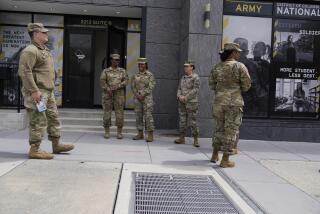U.S. ties troop levels to Iraqi elections
- Share via
WASHINGTON — The Bush administration believes a halt in troop reductions in Iraq after July is needed in part to ensure a large enough force is present to provide security for local elections, a senior administration official said Friday.
By tying troop levels to Iraq’s provincial elections, officials in effect established a new milestone to guide U.S. policy during President Bush’s last months in office. And by linking them to the elections, the administration is increasing pressure on the Iraqis to actually hold the balloting.
Iraq’s presidency council, consisting of three top officials, vetoed legislation this week that set plans for the provincial elections, which the U.S. regards as one of the benchmarks of political progress in Iraq.
Under the current plan, troop reductions will take place as scheduled through July to remove the additional forces sent last year as part of a U.S. buildup, the senior administration official said. But once the extra forces are withdrawn and troop levels decline to about 140,000, no further reductions would occur until late in the year.
“You can actually increase your own risk if you pull out too many simultaneously,” the official said, denying that the move was intended to avert drastic changes in war policy until a new president takes office in January. “This is not a stall tactic. It’s not an attempt to put off the inevitable until after Jan. 20.”
The official spoke on condition of anonymity because no final decisions on troop levels will be made until Army Gen. David H. Petraeus, the top U.S. commander in Iraq, presents recommendations to President Bush next month. Those recommendations are expected to include his proposal to hold off on further reductions until at least September.
The official also cast doubt on Army plans to shorten combat tours from 15 months to 12 months after the current round of troop reductions is completed in July. Tours were extended to 15 months last year to support the U.S. buildup, but the extra time has added to strain on Army units.
An additional 21,500 combat troops and several thousand support troops were sent to Iraq last year in an effort to increase security.
A delay in further withdrawals could exacerbate tensions between U.S. commanders in Iraq, who want to maintain high troop numbers to preserve the gains they say they have made, and military leaders at the Pentagon, who want to ease the strain on the Army and Marine Corps.
After Petraeus in January recommended holding off on reductions after this summer, the chairman of the Joint Chiefs of Staff, Navy Adm. Michael G. Mullen, said he hoped withdrawals would continue. Days later, Defense Secretary Robert M. Gates, who once hoped for drastic troop reductions by the end of 2008, came down in support of Petraeus.
The senior administration official emphasized that there would be cuts after the formal end of the troop buildup in July. But a delay of four to six weeks, or longer if provincial elections are delayed, means the next round of cuts probably will be more modest than Mullen and Gates originally wanted.
“There are going to be additional reductions,” the official said. “We do not intend to stay there forever. . . . I think before the end of ‘08, we are going to see additional drawdowns.”
Administration officials have been pushing for provincial elections in Iraq as a major step toward national reconciliation. The White House was pressing for an October vote.
Iraq’s presidency council gave only vague reasons for vetoing the law, which also sets out the powers of the local governments. Iraqis are bitterly divided over the balance of power between Baghdad and provincial governments.
By July, there will be the equivalent of 15 U.S. brigades in Iraq, accounting for the 140,000 troops, a number that fluctuates depending on the configuration of forces and addition of support units. If the break in further withdrawals lasts through elections in October, it is likely there will be no fewer than 13 brigades in Iraq by the end of the year.
Gates expressed hopes last year that by the end of the Bush administration, there would be about 10 brigades in Iraq.
Since the announcement of the first cuts last year, Petraeus has withdrawn some Marine units but only one Army brigade. The next withdrawal of an Army brigade is scheduled for this month.
Although Mullen and Gen. George W. Casey Jr., the Army chief of staff, oppose a rapid withdrawal, both spent time this week stressing the need to reduce the burden on American troops by shortening combat tours.
To do that, several of the service chiefs favor a steadier reduction in the number of combat forces in Iraq.
Casey said at a Senate hearing this week that he planned to reduce tours from 15 months to 12 by January.
But the senior administration official said it was important to avoid returning to the days before 15-month combat tours, when commanders often ordered ad hoc extensions of units, forcing some to stay longer than 12 months, often with little notice. The continuing demand for troops means that a uniform 12-month tour policy would be difficult, the official said.
“This is not done yet,” the official said of Army plans to return to 12-month tours. “I don’t think the analysis is complete. We are going to hear more about this.”
--
julian.barnes@latimes.com
More to Read
Sign up for Essential California
The most important California stories and recommendations in your inbox every morning.
You may occasionally receive promotional content from the Los Angeles Times.














